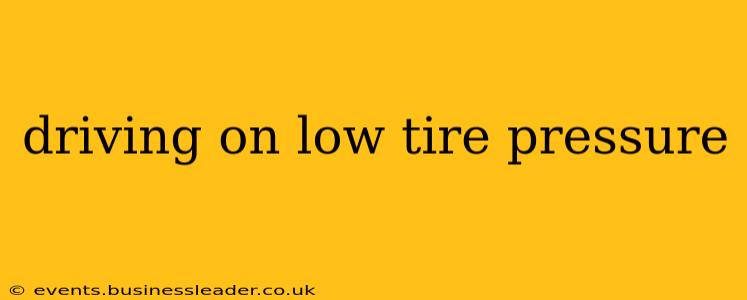Driving on low tire pressure is more common than you might think, and it presents a significant safety hazard. Ignoring low tire pressure can lead to accidents, damage to your vehicle, and costly repairs. This comprehensive guide will explore the risks, signs, and actions to take when faced with under-inflated tires.
What are the Risks of Driving on Low Tire Pressure?
Driving with low tire pressure significantly increases your risk of accidents. Here's why:
-
Reduced Traction and Handling: Under-inflated tires reduce the contact patch between the tire and the road, leading to decreased traction, especially in wet or icy conditions. This makes it harder to steer, brake, and accelerate safely, increasing the chances of skidding or losing control.
-
Increased Risk of Blowouts: As the tire flexes more with low pressure, it generates excessive heat, weakening the tire structure and increasing the risk of a blowout. A blowout can cause sudden loss of control, potentially leading to a serious accident.
-
Higher Fuel Consumption: Under-inflated tires cause increased rolling resistance, meaning your engine has to work harder to maintain speed. This leads to significantly higher fuel consumption, costing you more money at the pump.
-
Uneven Tire Wear: Low pressure causes the tire to wear unevenly, particularly on the outer edges. This reduces the tire's lifespan and necessitates premature replacement, adding to your expenses.
-
Damage to Vehicle Components: Driving on consistently low tire pressure can damage other parts of your vehicle, such as the wheel rims, suspension, and even the wheel bearings. These repairs can be expensive.
What are the Signs of Low Tire Pressure?
Several indicators can alert you to low tire pressure. Pay close attention to:
-
The Tire Pressure Monitoring System (TPMS) Warning Light: Most modern vehicles are equipped with a TPMS that illuminates a warning light on your dashboard when tire pressure falls below a safe level. This is your first and most important sign.
-
Visible Flattening of the Tire: A noticeably deflated tire is an obvious sign of low pressure. You might notice the sidewall bulging more than usual.
-
Unusual Vehicle Handling: If your vehicle feels sluggish, pulls to one side, or handles differently than usual, low tire pressure could be the culprit. You might also experience increased vibration, especially at higher speeds.
-
A "Thumping" Sound: While driving, you might hear a thumping or thump-thump sound, indicating that the tire is losing air.
How Often Should I Check My Tire Pressure?
You should check your tire pressure at least once a month, and ideally before every long trip. Remember to check the pressure when the tires are cold (i.e., the vehicle hasn't been driven for at least three hours). The recommended tire pressure is usually listed in your vehicle's owner's manual or on a sticker located inside the driver's side doorjamb.
What Should I Do if I Have Low Tire Pressure?
If you notice any signs of low tire pressure, take immediate action:
-
Pull over to a safe location: Avoid sudden braking or maneuvering.
-
Assess the situation: Check all four tires for visible damage or punctures.
-
Add air to the tires: Use a reliable air compressor or visit a gas station with an air pump. Inflate the tires to the recommended pressure.
-
Monitor the pressure: Continue monitoring your tire pressure regularly, even after inflating them. If the pressure continues to drop, you likely have a leak and need professional help.
-
Visit a tire professional: If you can't find the source of the leak or suspect a puncture, take your vehicle to a tire shop for repair or replacement.
Can I Drive on Low Tire Pressure for a Short Distance?
While you might be tempted to drive a short distance on low tire pressure, it's strongly discouraged. Even a short drive can cause significant damage to your tires and other vehicle components, making it riskier and more costly in the long run. It's always better to prioritize safety and pull over immediately.
How Much Lower Can My Tire Pressure Be Before I Should Worry?
The amount by which your tire pressure can drop before you should worry depends on several factors, including the severity of the under-inflation and the specific tire. A general rule of thumb is that if your tire pressure is more than 10 psi below the recommended pressure, you should address the issue immediately. However, it's best to consult your vehicle’s owner's manual for specific guidelines.
What Causes Low Tire Pressure?
Several factors can contribute to low tire pressure, including:
-
Slow leaks: Punctures from small objects, like nails or screws, or slow leaks from damaged valve stems.
-
Temperature changes: Tire pressure decreases as the temperature drops.
-
Natural air leakage: All tires lose a small amount of air over time due to natural permeability.
-
Improper inflation: Incorrectly inflated tires can lead to pressure loss over time.
By understanding the risks, signs, and actions to take when faced with low tire pressure, you can significantly improve your safety and maintain your vehicle's health. Remember, preventing low tire pressure is crucial for safe and efficient driving.
